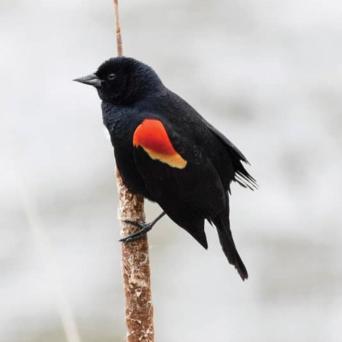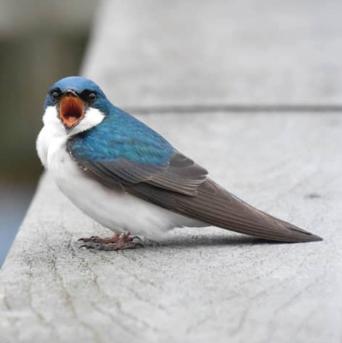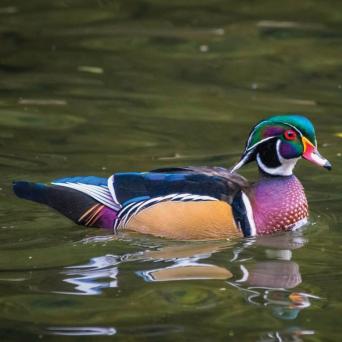Tips on Photographing Birds, Once They Get Back in Town
Even without a calendar, one of the sure signs that spring is right around the corner is the return of our bird friends from their winter homes in warmer climates. Whether it’s in my backyard or in Wissahickon Valley Park, I find so much pleasure in searching for and watching birds. So does hobby naturalist and wildlife photographer Troy Bynum, who features his wonderful photos of birds and other local animals as host of Wildlife Wednesdays on FOW’s Instagram page.
Troy has been passionate about and inspired by nature and wildlife since childhood, but his true interest in birds emerged when he moved back to Philadelphia in 2017 and went hiking with friends in the Wissahickon every weekend. He remembers seeing in the park one day what he calls his “spark” bird – the one that truly sparked his interest in bird photography: a beautiful green heron. Troy is drawn to patterns and colors in nature, and there’s no shortage of either when it comes to birds.
When the pandemic hit, Troy, like so many of us, headed to the Wissahickon for serenity, solace, and the need to focus on something other than the world’s chaos. With an abundance of birds in the park, they seemed like the natural choice for his subjects.
FOW recently checked in with Troy to find out what we can look forward to seeing during the spring bird migration. He explained that while it starts in mid-March, we won’t see the full effect until April. During that time, he recommends watching for these featured friends of the Wissahickon:
- Red-Winged Blackbirds: The males arrive first to claim their territory for the females, who arrive a bit later. With their loud, squawking, screeching call, you may hear them before you see them.
- Tree and Barn Swallows: You will recognize them as the large numbers of small birds zipping back and forth through the skies, snatching up insects.
- Broad-Winged Hawks: Unlike the Sharp-Shinned, Cooper’s, and Red-Tailed hawks, which stay throughout the winter, Broad-winged hawks migrate. Despite its name, this is one of the smallest hawks — about the size of a crow. Like others of its species, the broad-winged will usually be found either perched in a tree or hunting prey.
- Eastern Bluebirds and American Goldfinches: When the spring and summer are in full swing, the blue and gold of these two field birds are true showstoppers. But when they return to our area in the spring, look for more muted, duller plumage until their vibrant spring colors come in.
The bird boxes that FOW installed in Andorra and Houston meadows are prime real estate for returning birds and others, such as bluebirds and tree swallows, that begin their nesting season in early spring. As part of our Ecological Land Management Plan, we placed wood duck boxes along the creek a number of years ago. That has helped increase the nesting population of these stunning birds, who are cavity nesters. During the first few weeks of March, you might also spot a male with a couple of females, searching for an appropriate tree cavity in which to settle.
Tips for beginning bird photographers:
- Go out early and often Troy likes to get to the park before sunrise, when activity is starting to happen.
- Find the food sources The best spot to find migrating birds hungry from traveling thousands of miles is wherever the food is. There are hot spots all over the park, but birds such as warblers, indigo buntings, and other spring migrants enjoy the berries on trees and bushes in Andorra and Houston meadows. Be patient and be prepared to stay a while.
- Contain your excitement Any sudden movements or noises will cause your precious find to fly off before you can even get the camera to your eye. This is still one of Troy’s biggest challenges!
- Phones are great Cameras on today’s mobile phones are quite sophisticated. They have many features you’ll find on a real camera, such as high resolution and a variety of lenses and light exposures. Attachments are available that slide over the lens and make the camera almost like a spotting scope to zoom in and record what you see.
- Make it a family affair It’s never too early to engage your children in the love of nature and wildlife and nurture their future environmental stewardship. One of Troy’s favorite pastimes is taking his six-year-old daughter to feed the ducks (grains, peas, lettuce, or halved grapes, please; not bread, which sickens them) along the creek at Valley Green Inn, or to watch hawks and kestrels at the Dixon Meadow Preserve. Her curiosity and enthusiasm inspire his ongoing involvement with nature.
Join Troy for #WildlifeWednesdays and visit @tb_wildlife_photography.



